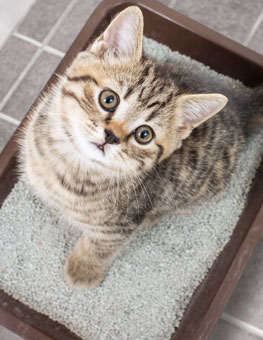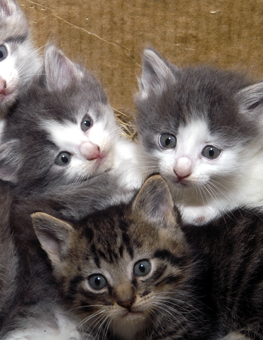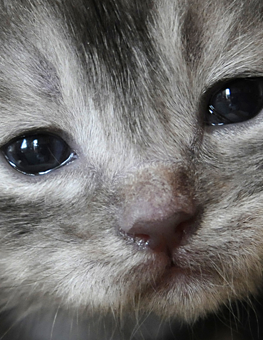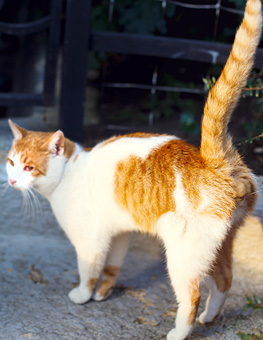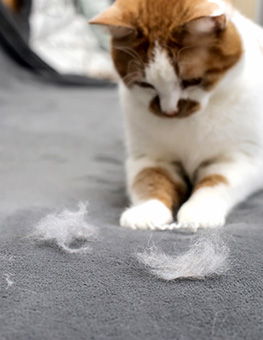Managing Cat Incontinence
Managing cat incontinence means less stress for you and more comfort for your pet.
Cat incontinence, meaning the involuntary leakage of urine or feces, can be a challenging issue for pet owners, particularly as their beloved felines age. Senior cats are more prone to incontinence, though it could also be a congenital issue in younger cats as well. Constant messes around the house are stressful to you, and likely are uncomfortable for your cat. Understanding the causes, treatments, and management strategies for cat incontinence can make life easier for both you and your incontinent cat.
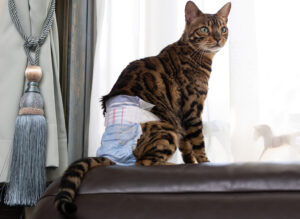
Cat incontinence can be embarrassing for you and uncomfortable for your cat.
What are the Symptoms of Cat Incontinence?
Incontinence in cats can often be confused with undesirable elimination or defecation, where the cat is urinating or defecating voluntarily. Cats who are incontinent will involuntarily empty their bladder or bowels. Common signs and symptoms of cat incontinence include:
- Your cat seems unaware of urination or defecation occurring.
- The cat does not squat or get in position to eliminate.
- You find urine or feces in the cat’s bed during or after their nap.
- The cat stands near the litter box to eliminate, but seems to not have made it there in time.
- Your cat may have urine or stool staining, redness and inflammation, or frequent licking around the anus or genital area.
You may see hind end weakness or changes in how your cat carries his tail.
What are the Causes of Cat Incontinence?
There are many factors that can contribute to incontinence in cats, especially in senior cats:
- As your cat ages, the muscles controlling his bladder and bowel movements may weaken. With weaker muscles, he may lose the ability to control himself.
- Frequent urinary tract infections, diabetes, and chronic kidney disease, can lead to a sense of urgency in urinating and ultimately accidents outside of the litter box.
- Prolonged constipation or diarrhea may lead to fecal incontinence in cats.
- Neurological issues such as spinal cord damage commonly cause cat incontinence.
- Older cats may develop cognitive dysfunction or dementia that leads them to not be aware of their surroundings or how they are behaving.
Cat Incontinence Treatment Options
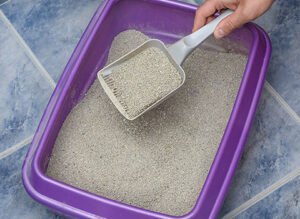
Keeping an eye on your cat's litter box behavior can give you an early warning about incontinence issues.
Treatment for cat incontinence largely depends on the underlying cause. However, there are a few common treatments and ways to manage symptoms, even if the incontinence is irreversible:
- Medications such as antibiotics for urinary infections or anti-inflammatory drugs for arthritis can help manage incontinence.
- Special diets can help manage conditions like diabetes and kidney disease, potentially reducing incontinence related to these medical issues.
- For structural issues or severe cases, surgery may be necessary to correct the problem.
Managing Cat Incontinence with Diapers
Cat incontinence diapers can be a helpful tool in managing accidents and maintaining a clean home environment in cats with urinary or fecal incontinence. Hartz® Disposable Cat Diapers with FlashDry® Gel Technology are easy to put on and stay on and provide 12-hour leak-proof protection for your cat. Here are some best practices for using diapers to manage incontinence:
- Choose the right size. Ensure the diaper fits your cat snugly, but comfortably. This will keep it in place and guarantee that your cat stays comfortable and leak-free. Hartz® Disposable Cat Diapers come in four different sizes to ensure maximum comfort for your incontinent cat.
- Be sure to change the diaper frequently to prevent skin irritation and infections.
- Watch for signs of discomfort or distress in your cat, and adjust the diaper as needed.
Managing cat incontinence, particularly in our senior cats, requires patience and understanding. However, with proper care and attention, your cat can continue to enjoy a comfortable and happy life, and you can continue to keep your home clean and sanitary. Always consult with your veterinarian for the best advice and treatment plans tailored to your cat’s specific needs.



